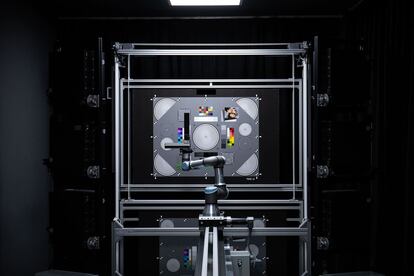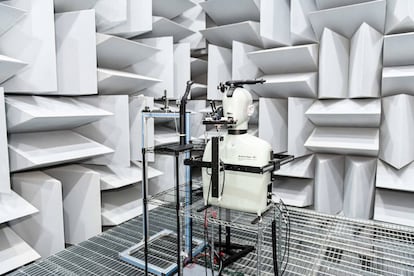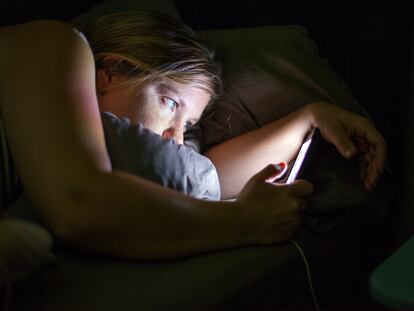A robotic head and phones falling from the sky: Inside a Xiaomi laboratory in Beijing
EL PAÍS visits a factory of the Chinese company where devices are subjected to exhaustive quality control tests before reaching the market

The day that Xiaomi was born, its founders ate porridge made of millet, the grain that gives the brand its name. Since that day, April 6, 2010, the technology company has grown unceasingly. More than a decade later, it has formed an empire, becoming the brand with the third-highest cell phone sales on the planet, behind Samsung and Apple, according to the consulting firm Canalys. Before reaching users’ hands, its phones are subjected to a series of quality control experiments, from being dropped onto marble surfaces to rigorous folding tests.
Xiaomi operates approximately 300 laboratories in countries including China, Japan, Finland and India. The company’s Science and Technology Park in Beijing, which was inaugurated in 2019, has 128 laboratories on 12,000 square meters, with equipment worth over €91 million. EL PAÍS visited one of them on a trip sponsored by Xiaomi.
Testing the camera

A white hallway with lights in the shape of a hexagon leads to the laboratory’s entrance. For a few seconds, one has the sensation of entering the future. But what is revealed is the quality control that Xiaomi phones face before entering the market. In one room, called the “camera lab,” a robotic arm moves back and forth on a horizontal metal bar. It holds a telephone that points with its camera at a board with a variety of shapes and images. “The arm moves back and forth to control the shooting distance,” explains an employee.
The phone points at colorful squares and a photo of three women, with the purpose of testing the color and evaluating how the camera captures skin colors. To test textures, there is an image of marble and another of grass. Around the room, bulbs simulate different kinds of lighting, from interior to natural to darkness.
Rigorous folding tests
Among premium mobile phones, foldable smartphones are set to be the segment with the greatest market growth during this decade, according to the consulting firm Strategy Analytics. The devices can withstand thousands of folds and are ever more resistant. The folding hinge used by brands like Xiaomi, Oppo and Samsung can endure over 200,000 bends, or 100 bends a day for five years.
Xiaomi tests the durability of devices like the Xiaomi Mix Fold 2 in its folding test laboratory. The company uses a machine that automatically opens and closes phones over and over. In addition to evaluating the screen’s resistance, the laboratory also conducts tests to control the humidity and temperature that the devices can withstand.
Cell phones that look for their own failures
In the stability laboratory, dozens of cellphones line the walls, working alone. While some open and close applications over and over, others conduct Google searches, write messages or use the calculator. With these tests, Xiaomi’s objective is to prove that the phones work perfectly and detect possible incompatibility problems. If a phone passes the test it has been assigned, the word pass appears on its screen. If not, the panel turns orange and shows a code.
Throwing phones from the heights
A Xiaomi employee inserts a phone into a machine, which lifts it and drops it on a marble surface. This practice tests smartphones’ durability. “It’s a directional drop machine, and it can make the device fall at any angle or direction,” the employee explains. In its tests, Xiaomi throws the phones from different heights, positions and velocities.
The room includes other machines, such as the steel ball drop. “Imagine this scenario. You get home and you put your phone on the table, where there are some keys, and you accidentally drop it,” the employee says. Replicating such conditions can be complicated. That is where the machine comes into play. The phone is placed on a flat surface, and the steel ball applies pressure on it.
A head simulator to test audio

The walls of the audio lab are covered with geometric folds that absorb sound. Absolute silence reigns. “The noise is below 15.9 decibels,” explains the Xiaomi employee. (A normal conversation can be around 65 dB, and a shout is typically 80 dB.)
In the center of the room, a shoulder and head simulator has a mouth that acts as a speaker and two ears that act as a microphone “to receive and process the sound.” In tests, the phone is sometimes placed next to the ears to simulate a phone call and sometimes in front of the face to recreate a video call. To create a test environment as close to reality as possible, there are also loudspeakers that generate background noises that users encounter in their daily lives, such as a supermarket or factory.
From 5G to GPS

Among the most visually striking laboratories is one with blue spikes all over the walls. It is the OTA, or Over The Air, Lab, designed to evaluate the transmission and reception performance of the cell phone antenna. It simulates all types of signals —2G, 3G, 4G, 5G and GPS— and tests are carried out to ensure the phone’s optimal connection in all circumstances.
A cell phone ready for electromagnetic waves
The walls of the EMC Lab, or electromagnetic compatibility laboratory, are covered with white and gray blocks that absorb electromagnetic waves and prevent them from interfering with the tests. The purpose of this room is to “prepare cell phones for interference from other devices and the real world’s complex electromagnetic environment.”
Inside, there are two antennas, one for tests below 3G and one for those above. For some tests, the cell phone is placed on a rotating table. “The permittivity (the ability to allow the formation and propagation of electric fields) of the board is 1.1. That means it is very close to that of air, so overall it will have little impact on the test,” explains the Xiaomi employee. Outside this room, a computer displays a graph with two lines: one gives data on international standards and the other on test results.
Xiaomi goes all in on mobile photography with the 13 Ultra
The Chinese giant’s latest bet to win over photography fans is the Xiaomi 13 Ultra, presented last April 18 in Beijing. The device has a gigantic module with four 50-megapixel cameras, including one with a one-inch main sensor and variable aperture. The brand is collaborating with Leica, the German camera manufacturer, in order to make advances in mobile photography.
Sign up for our weekly newsletter to get more English-language news coverage from EL PAÍS USA Edition
Tu suscripción se está usando en otro dispositivo
¿Quieres añadir otro usuario a tu suscripción?
Si continúas leyendo en este dispositivo, no se podrá leer en el otro.
FlechaTu suscripción se está usando en otro dispositivo y solo puedes acceder a EL PAÍS desde un dispositivo a la vez.
Si quieres compartir tu cuenta, cambia tu suscripción a la modalidad Premium, así podrás añadir otro usuario. Cada uno accederá con su propia cuenta de email, lo que os permitirá personalizar vuestra experiencia en EL PAÍS.
¿Tienes una suscripción de empresa? Accede aquí para contratar más cuentas.
En el caso de no saber quién está usando tu cuenta, te recomendamos cambiar tu contraseña aquí.
Si decides continuar compartiendo tu cuenta, este mensaje se mostrará en tu dispositivo y en el de la otra persona que está usando tu cuenta de forma indefinida, afectando a tu experiencia de lectura. Puedes consultar aquí los términos y condiciones de la suscripción digital.
More information
Archived In
Últimas noticias
Most viewed
- Pablo Escobar’s hippos: A serious environmental problem, 40 years on
- Reinhard Genzel, Nobel laureate in physics: ‘One-minute videos will never give you the truth’
- Why we lost the habit of sleeping in two segments and how that changed our sense of time
- Charles Dubouloz, mountaineering star, retires at 36 with a farewell tour inspired by Walter Bonatti
- The Florida Keys tourist paradise is besieged by immigration agents: ‘We’ve never seen anything like this’











































